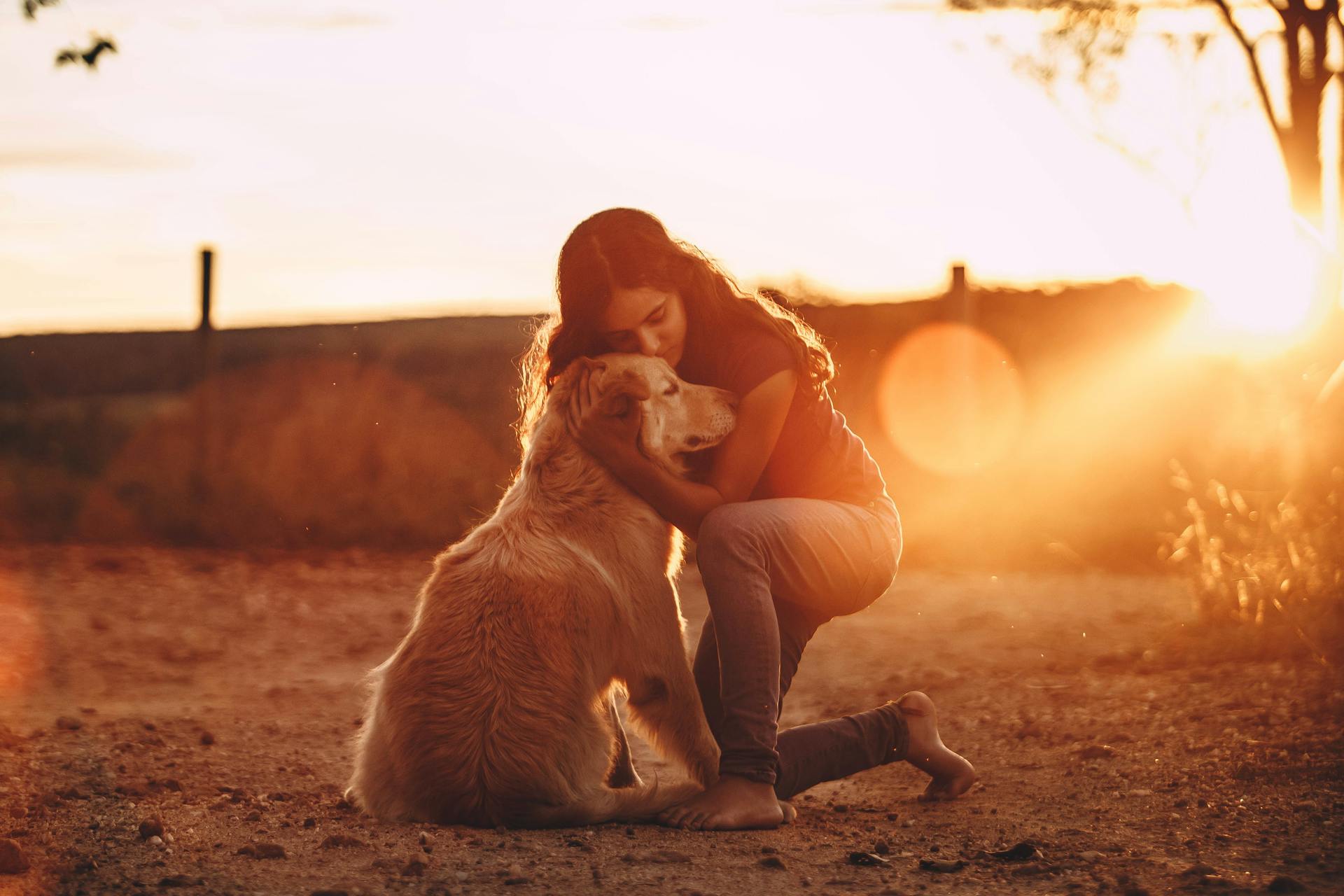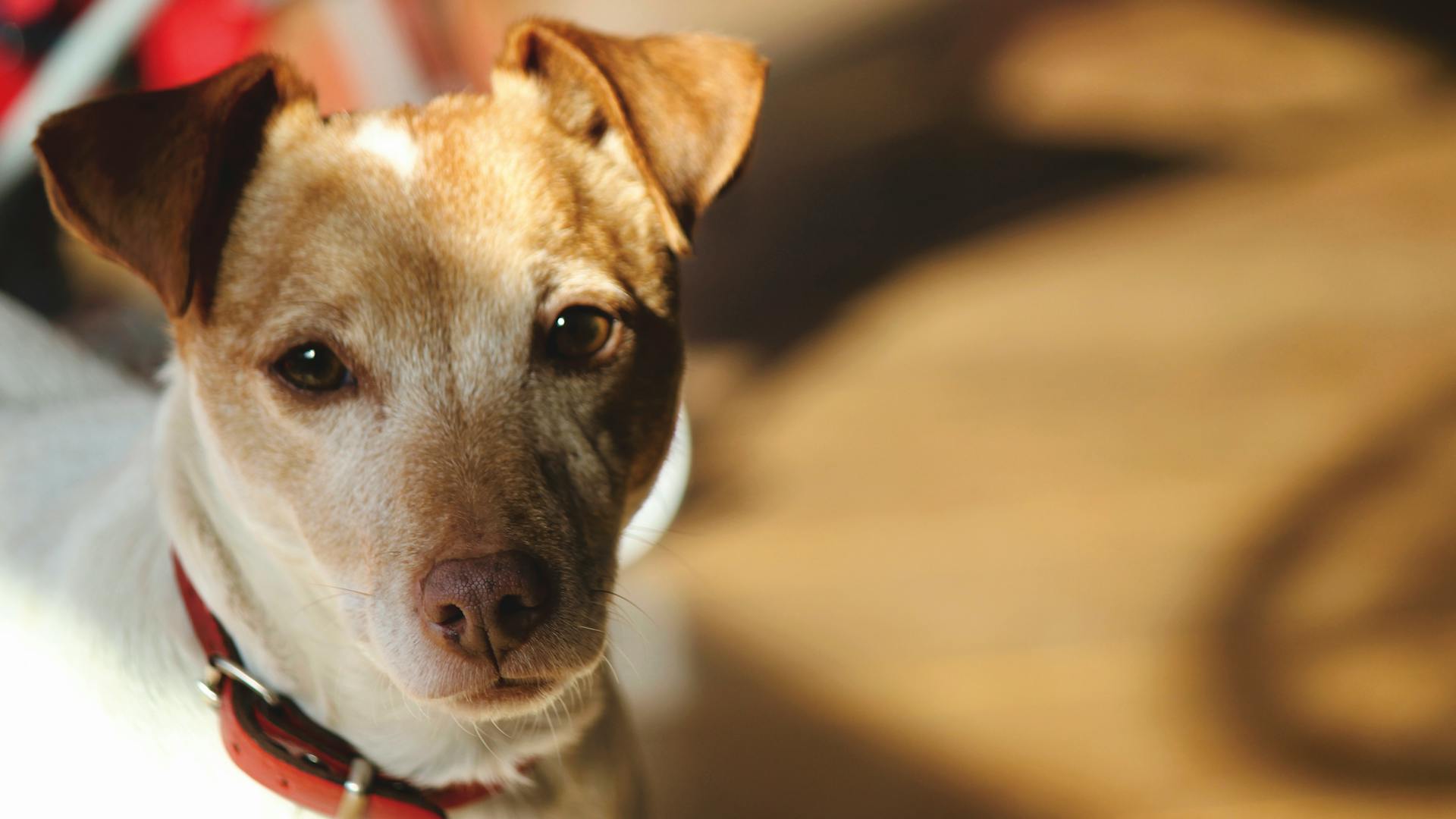
Golden Retrievers are known for their luscious coats, but did you know they're actually double coated? This means they have two layers of fur: a thick undercoat and a coarser outer coat.
Golden Retrievers shed heavily, especially during spring and fall when the weather changes. This is because their double coat is designed to adapt to the seasons.
Their undercoat traps warm air next to their skin, keeping them cozy in cold weather. In warmer months, the undercoat sheds to prevent overheating.
Regular brushing is essential to reduce shedding and prevent matting of the undercoat.
Consider reading: Pit Bulls in Cold Weather
What Is a Double Coat?
A double coat on a dog is made up of two layers: an undercoat and a top coat. The undercoat is usually made up of short hairs, while the top coat has longer hairs called guard hairs.
The undercoat provides insulation and protects the dog from the weather and elements. This means that double-coated dogs can stay warm in the winter and cool in the summer.
For more insights, see: Frenchie Top Dog
The top layer of the double coat repels dirt and moisture, which helps to keep the dog's skin healthy. However, this also means that double-coated dogs tend to shed a lot more than dogs with single coats.
Double-coated dogs shed their fur in a process called "blowing coat", which can last for 2-3 weeks. This can be a bit of a challenge for dog owners, but regular grooming can help to keep their coat and skin healthy.
Here are some benefits of a double coat:
- Keeps dogs warm in the winter
- Keeps dogs cool in the summer
- Acts as a natural sunscreen
- Repels dirt and moisture
As a dog owner, it's essential to research the needs of a double-coated breed before bringing one home. This includes understanding their grooming needs and how to introduce them to regular grooming routines.
Characteristics of Double-Coated Dogs
Double-coated dogs have two layers of fur: a thick, coarse top coat and a soft undercoat. This unique coat structure helps them stay warm in winter and cool in summer.
The top coat repels dirt and moisture, while the undercoat provides insulation. In the summer, the undercoat helps keep a dog cool and acts as a natural sunscreen. In the winter, it makes them warm and helps their skin stay healthy and dry.
Double-coated dogs shed their undercoat in a seasonal process called "blowing coat", which can last for 2-3 weeks. This intense shedding can be a challenge for dog owners, but regular grooming can help manage the process.
Some common characteristics of double-coated dogs include:
- Excessive shedding, especially during seasonal changes
- A thick, coarse top coat and a soft undercoat
- A tendency to mat and tangle if not properly groomed
- A need for regular brushing and bathing to prevent matting and tangling
These characteristics require regular grooming to prevent matting and tangling, and to keep their coat healthy and looking its best.
Grooming and Shedding
Golden Retrievers are indeed double-coated dogs, and their shedding habits are a testament to this unique feature. They shed heavily, especially during the spring and fall when they "blow their coats" for about 3 weeks.
Their thick double coat repels dirt and moisture and acts as a cooling system in the summer, while also keeping them warm and dry in the winter. This means they need regular grooming to prevent matting and tangling, which can be painful and lead to fleas and ticks.
Golden Retrievers typically shed the most during the fall and spring, but they shed year-round. To manage their shedding, it's essential to brush them regularly, at least once every few days, to remove loose and dead hair. You can use a quality grooming tool like a slicker brush or a deshedding tool to reach through their double coat and remove loose hair effectively.
Here's a rough guide to brushing your Golden Retriever's coat:
Bathing your Golden Retriever can also help control shedding, but be careful not to overdo it, as this can strip their coat of natural oils. You should bathe them regularly, but not too frequently, to maintain proper hygiene and prevent skin conditions.
By understanding their unique coat and shedding habits, you can provide the best care for your Golden Retriever and keep them looking and feeling their best. Regular grooming and brushing can help minimize excess shedding, prevent painful mats, and promote a healthy, shiny coat.
Curious to learn more? Check out: Bichon Frise Not Groomed
Managing Double-Coated Dogs
Managing double-coated dogs requires regular grooming to prevent matting and tangling. They need to be brushed daily and bathed once a month.
Double-coated dogs have two layers: a topcoat and an undercoat. The topcoat repels dirt and moisture, while the undercoat provides insulation and serves as a natural sunscreen and warmth.
To groom your double-coated dog, start by brushing or combing the undercoat to remove loose hair, working in sections to lift the hair and brush underneath. Use a brush or comb with longer pins to reach the undercoat.
Here are some key grooming practices to follow:
- Brush or comb the undercoat daily
- Bathe once a month
- Use a dog-specific hair dryer to dry the undercoat
- Use a stiff bristle brush or grooming glove to brush the coat after bathing
Regular grooming will help prevent matting and tangling, and keep your double-coated dog healthy and comfortable.
Strategies for Handling
Caring for a double-coated dog's coat is an important part of owning one. Remember, our dogs rely on us to care for their unique needs.
Golden Retrievers shed like their lives depend on it, so it's crucial to establish a regular grooming routine. Brushing them at least twice a week can help reduce shedding and prevent matting.
If you're not sure you can handle the shedding, it's worth considering a different breed. Caring for a Golden Retriever's coat is an unavoidable part of owning one.
How to Manage
Managing double-coated dogs can be a challenge, but with the right approach, you can keep your furry friend looking and feeling their best.
Regular grooming is essential for double-coated dogs, as it prevents matting and tangling of their fur. This should be done daily, with a focus on brushing or combing the undercoat to remove loose hair.
Double-coated dogs have two layers: a guard hair outer coat and a soft undercoat. The outer layer repels dirt and moisture, while the undercoat serves as insulation, keeping your dog cool in summer and warm in winter.
To groom your double-coated dog effectively, you'll need to brush or comb the undercoat regularly, using a brush or comb with longer pins to reach this layer. Go through section by section, lifting the hair and brushing underneath until you've brushed the entire undercoat.
Here are some general guidelines for grooming your double-coated dog:
It's also essential to introduce your dog to grooming tools and handling early on, as part of their behavioral training. This will help them become more comfortable with the process and make it easier for you to care for their coat.
Remember, double-coated dogs rarely need shaving, and unnecessary shaving can compromise their coat's integrity and function. If you're concerned about heatstroke, talk to your vet about other ways to keep your dog cool in hot weather.
For more insights, see: Shaving Double Coated Dogs
A Nutrition-Rich Diet Can Reduce
A nutrition-rich diet can make a big difference in reducing shedding in double-coated dogs.
Your pup requires a diet rich in proteins and omega-3 fatty acids to maintain optimal health.
A strong, shiny coat that sheds less is a sure sign that their diet is healthy and free of allergens.
Golden Retrievers, in particular, benefit from a diet rich in proteins and omega-3 fatty acids to maintain their optimal health.
You do need to pay attention to what you're feeding your furry friend, as a poor diet can lead to excessive shedding and skin problems.
Discover more: Shiba Inu Dog Health Problems
Reducing Shedding and Maintenance
A diet rich in proteins and omega-3 fatty acids can help reduce Golden Retriever shedding.
You can achieve a strong, shiny coat by giving your pup the nutrients they need, which shows in their reduced shedding.
Feeding your Golden Retriever a healthy diet can also make their coat less prone to allergens.
A Golden Retriever's coat is a sure sign of their diet's quality, so keep an eye on those food labels.
By providing the right nutrients, you can enjoy a lower-maintenance coat that sheds less.
Frequently Asked Questions
Is it okay to shave a Golden Retriever?
No, shaving a Golden Retriever is not recommended due to potential skin problems and coat regrowth issues. Learn more about proper grooming for this breed to maintain its health and appearance
At what age does a Golden Retriever get its full coat?
A Golden Retriever's full coat develops over 18 months, with adult fur growing in and forming an undercoat that remains throughout their life.
Sources
- https://pawsitivitypetspa.com/articles/double-coats-101
- https://k9000dogwash.com/everything-you-need-to-know-about-double-coated-dogs/
- https://www.dailypaws.com/living-with-pets/pet-compatibility/double-coated-dogs
- https://cuddleclones.com/blogs/all/managing-your-golden-retrievers-shedding
- https://inkopious.com/blogs/articles/how-much-do-golden-retrievers-shed-a-guide-to-golden-retriever-shedding
Featured Images: pexels.com


